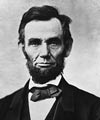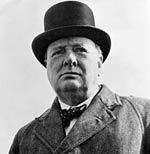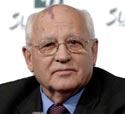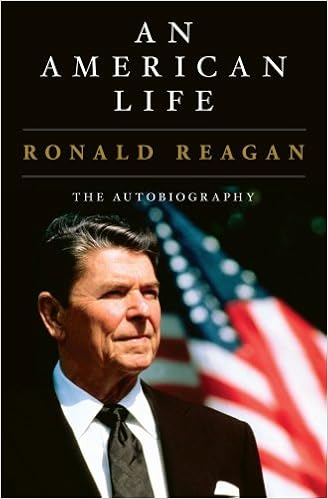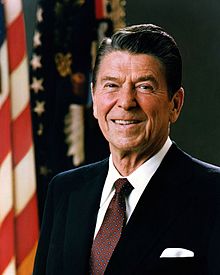
Early Life
Ronald Reagan was born 6 February 1911 in Tampico, Illinois. He attended Dixon High School where he gained an interest in acting and sports. He then attended Eureka College where he was elected president of the student body.
In the 1930s, Reagan gained work as a radio presenter commenting on baseball games. He made a strong impact because of his clear presentation and engaging voice. In 1937, Regan moved to Hollywood where he gained a contract with Warner Brothers. He was a prolific actor appearing in nineteen films by the end of 1939. Reagan later commented that with many films he worked on, directors were keen to get the movie finished as quickly as possible.
In 1942 he starred in ‘Kings Row’ – a film about a double amputee. His performance received critical acclaim, and it made him quite famous as a Hollywood actor. But, shortly after, he was drafted into active service in the U.S. Army. During the war, poor eyesight meant he was excluded from serving overseas. He worked in public relations and made several propaganda films, and helped in the War Loan drive to raise money for the cost of the war.
Reagan married for the first time in 1940, to actress Jane Wyman, having two children. Wyman later filed for divorce in 1948, not wishing to support Reagan’s political ambitions.
After the war, Reagan became president of the Screen Actors Guild. This involved representing actors in labour disputes; he also gave information to the FBI about actors with potential Communist sympathies.
It was as president of SAG that he met Nancy Reagan – ironically because Nancy had been mistakenly put on the list of ‘Communist sympathisers’. They married in 1952 and had two children – Patti and Ron.
Political career
Reagan began his political career as a Democrat. He supported Harry Truman in the 1948 election. However, his wife Nancy was a Republican, and in the 1950s, he drifted towards the Republican party. He supported the Presidential campaigns of Eisenhower (’52 and ’56) and Richard Nixon (1960)
In 1962, he formally joined the Republican party, stating that he didn’t leave the Democrat party, but the party left him.
Conservative beliefs
His political profile within the Republican movement rose sharply in 1964 when delivering a speech “Time for Choosing” for Presidential hopeful Barry Goldwater. Reagan stressed his philosophy which would characterise his political views. Reagan believed that government needed to be limited to prevent intrusion into individual liberties. Reagan was espousing a conservatism that would become popular in America. He was a member of the National Rifle Association and in the 1960s opposed some civil rights legislation because people should have the freedom to discriminate in housing if they wanted to. However, he claimed it was not from racist motives, and when growing up in the segregated South, he had offered accommodation to black people who were unable to stay at a hotel.
Ronald Reagan later paid credit to Martin Luther King for the peaceful civil rights movement of the 1960s.
“Abraham Lincoln freed the black man. In many ways, Dr. King freed the white man. How did he accomplish this tremendous feat? Where others — white and black — preached hatred, he taught the principles of love and nonviolence.” (15 January 1983)
Libertarianism and Conservatism
Reagan promoted a form of conservatism that in many regards had parallels to libertarianism – a very limited form of government. Or as Regan joke in 1965
“Government is like a baby. An alimentary canal with a big appetite at one end and no responsibility at the other.”
A typical summary of his ideology for limited government is expressed in this interview.
“The basis of conservatism is a desire for less government interference or less centralized authority or more individual freedom…But again, I stand on my statement that I think that libertarianism and conservatism are traveling the same path.” (Interview published in Reason (1 July 1975).
In the 1960s, Reagan spoke against ‘socialised healthcare’ and favoured reducing the welfare state.
“Welfare’s purpose should be to eliminate, as far as possible, the need for its own existence.” Interview, Los Angeles Times (7 January 1970).
Governor of California
In 1966, he was elected governor of California. His main policy planks were to reduce government spending, in particular, cut welfare spending, and to tackle the student anti-war/anti-establishment protests which were springing up in response to the Vietnam war.
As Governor Reagan was quick to send troops into Berkeley and other universities to crack down on protests. When quizzed about ‘Bloody Thursday’ – where a protester was killed by police. Reagan was unapologetic. “If it takes a bloodbath, let’s get it over with. No more appeasement.” Cannon, Lou (2003), p. 295. Reagan was supportive of the Vietnam war.
In 1976, his standing within the conservative movement encouraged him to stand for the Republican nomination. He lost to the more moderate Gerald Ford, but his campaign gave an impressive display of conservative strength, and in 1980 he gained the Republican nomination to fight Jimmy Carter.
President 1981-89
Against a backdrop of high inflation, low growth and the Iran hostage crisis. Reagan offered a radical agenda of economic neo-liberalism, a hard-line stance against Communism, state rights and strong national defence.
Reagan won a convincing electoral victory in 1981 making him the oldest person to be elected president, at the age of 69.
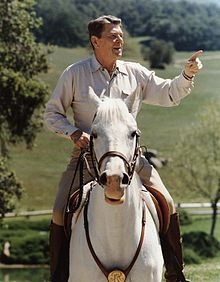
Within three months of his Presidency, Reagan was shot in an attempted assassination attempt. He narrowly survived and made a full recovery.
Social values
Reagan promoted conservative social values. This included trying to push a constitutional amendment to allow school prayer. He opposed abortion (though ironically as a new governor of California he signed a bill allowing abortion. Reagan later said he regretted the decision.) He also launched a renewed ‘war on drugs’ which took a hard-line approach to drug use. It led to more prison terms, (especially for Afro-Americans, the biggest users of Crack). For example, sentencing guidelines that meant that someone 5 grams (two sugar packets) worth of crack received an automatic five years in prison. The prison population soared during Reagan’s term. (And continued to rises after Reagan’s presidency.
More successful was the “Just say no” drug awareness campaign which sought to encourage young people to reject recreational drugs. First Lady Nancy Reagan was active in raising its profile across America.
On immigration Reagan was relatively liberal; in 1982, he allowed 3 million existing illegal immigrants to claim US citizenship. To stem further illegal immigrants, he passed a law to make it illegal to employ illegal immigrants.
Economic policy
In economics, he took a hard-line against trades unions, he implemented income tax cuts and attempted to reduce government spending.
“In this present crisis, government is not the solution to our problem; government is the problem. ” (1981 Inaugural address)
A plank of his economic policy was called ‘trickle down economics’. The idea that if the wealthy become better off, wealth and income will trickle down to all in society. Despite rhetoric to reduce government spending, overall government spending increased under Reagan, partly because of the expansion of military expenditure (40% increase between 1981 and 1985.
Also, although top rate income tax rates were cut from 70% to 50%, in 1981, other taxes were later raised. Tax as a % of GDP during his presidency was 18.2% – almost the same as the average tax rate 18.1% between 1970-2010. Despite a stance of fiscal responsibility, he presided over growing budget deficits, and overall national debt rose from $997 billion to $2.85 trillion, something Reagan described as his greatest disappointment. However, Reagan claimed strong economic growth during the 1980s was a vindication of his economic policies.
US Federal deficit
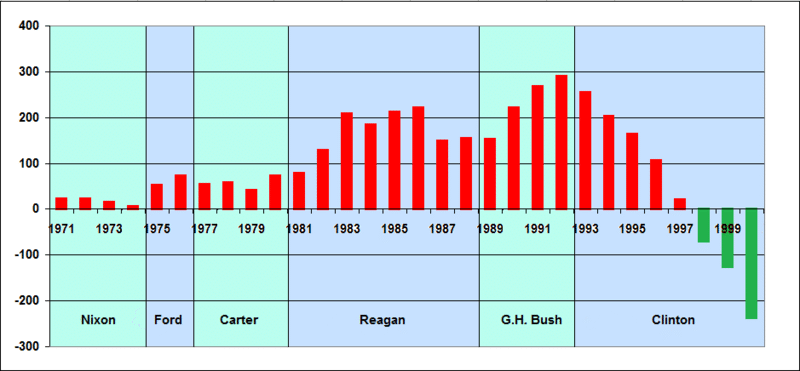
Reagan benefited from a fall in oil prices and the economic boom of the 1980s, which saw rising real incomes. But, the period also saw an increase rise in inequality with the gap between high earners and low earners increasing significantly.
Cold war rhetoric
Reagan was a fierce anti-communist all his life. On gaining the Presidency, he was criticised for escalated tensions with the Soviet Union, calling the Soviet Union ‘the evil empire’ (1983) and significantly building up the U.S. Military strength. However, while expanding the Star Wars programme, Reagan outlined his approach to foreign policy
“The defense policy of the United States is based on a simple premise: The United States does not start fights. We will never be an aggressor.”
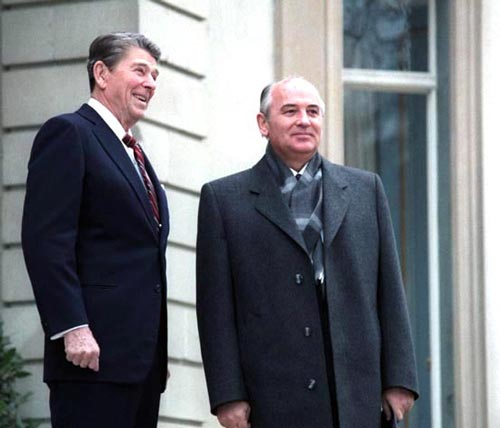
Reagan and Gorbachev, 1985.
Under the reforming Presidency of Mikhail Gorbachev, the Soviet Union became more committed to arms reduction and liberalisation through Gorbachev’s policy of Perestroika and Glasnost. Several treaties were signed which reduced the nuclear arsenals of both sides. In 1988, Reagan visited the Soviet Union, where he was well received. When asked if he still considered the Soviet Union the evil empire, Reagan replied “No, I was talking about another time, another era” Reagan expressed optimism about the direction the Soviet Union were taking under Gorbachev.
Gorbachev later said of Reagan:
“[Reagan] a man who was instrumental in bringing about the end of the Cold War” and deemed him “a great President”
In 1987, Reagan challenged the Soviet Union to go further:
“General Secretary Gorbachev, if you seek peace, if you seek prosperity for the Soviet Union and Eastern Europe, if you seek liberalization, come here to this gate! Mr. Gorbachev, open this gate! Mr. Gorbachev, tear down this wall!”
Ten months after he left office, in 1989, the Berlin wall did come down and the cold-war was officially declared over at a conference in Malta
Covert Anti-Communist action
As President, Reagan also supported aiding anti-communist movements across the world. The aim was to overturn any regime allied to the Soviet Union. Some of these anti-communist movements were also accused of severe human rights violations. These campaigns were funded secretly and supported by the CIA; this included supporting Afghan forces fighting the Soviet Union. Though ironically, these US weapons were later used by the Taliban against US forces who went to Afghanistan in the 2000s.
In 1983, Reagan sent troops to invade Grenada and overthrow the non-aligned Marxist government.
In 1986, the CIA was involved in clandestine activity in selling arms to Iran and using the proceeds to fund anti-Communist Contras in Nicaragua; this was made public in the Iran-Contra scandal. This had been outlawed by an act of Congress, but CIA had undertaken it on its own initiative. Regan denied direct knowledge.
It was a rare case of a scandal hitting the approval ratings of Reagan. Usually, he had the ability to deflect attention from scandals.
In 1986, a bomb exploded in a Berlin nightclub killing one US servicemen. Citing Libyan involvement, Reagan ordered a series of air-strikes against Libya, citing the US right to self-defence. In response, the United Nations General Assembly adopted a resolution which condemned the US attack. It was passed by a vote of 79 to 28.
A critical moment in Reagan’s second term was the Challenger disaster in 1986, where a US space shuttle exploded killing all seven astronauts on board.
After office, Reagan received much critical acclaim, and also much criticism. In August 1994, he was diagnosed with Alzheimer’s disease – which involves a slow and steady deterioration in the brain. After the diagnosis, Reagan retreated from public view. He died of pneumonia on 5 June 2004.
Citation: Pettinger, Tejvan. “Biography of Ronald Reagan”, Oxford, UK. www.biographyonline.net, Published 31st January 2015. Last updated 18 February 2018.
An American Life: The Autobiography
An American Life: The Autobiography
at Amazon
The Reagan Diaries
The Reagan Diaries at Amazon
Related pages
